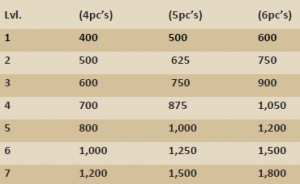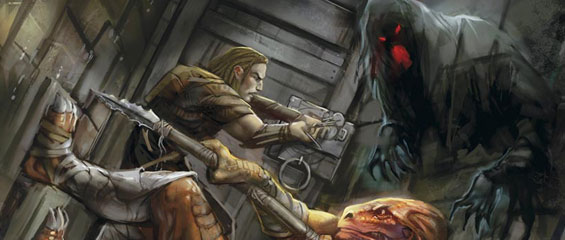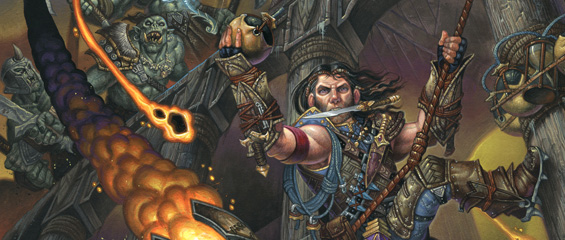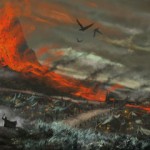Encounter Building Sacrosanct
What I’m about to suggest to you, some may consider sacrilege. It may be mechanically unsound, “unbalanced” or just plain stupid depending on whom you ask but I’m going to say it anyway. Abandon the XP budget.
Until recently I think I was doing what perhaps a lot of other DM’s are doing when sitting down to build an encounter, I’d look at my setting and perhaps think about what kind of denizens/traps/terrain I wanted my players to encounter and scoot right over to the XP budget chart to plug things in. I mean, had a general rule of thumb about how I wanted things to pan out, not saying I looked at “500xp” and thought “how many skeletons can I fit into this” and stopped right there, but it wasn’t really all that far from it either.
Thinking Outside the Chart
 Stepping out of my encounter building box and looking at it from an external perspective makes it seem like a very mechanical process. I have X amount of space, what can I cram into it? I found myself hunting for target numbers instead of target experiences for my players. It felt like I was trying to figure out if there was enough save “blocks” left on my playstation memory card to fit in another Diablo savegame.
Stepping out of my encounter building box and looking at it from an external perspective makes it seem like a very mechanical process. I have X amount of space, what can I cram into it? I found myself hunting for target numbers instead of target experiences for my players. It felt like I was trying to figure out if there was enough save “blocks” left on my playstation memory card to fit in another Diablo savegame.
The whole idea seems a bit counterproductive to making well thought out, detailed, interesting and evocative encounters. Well structured? Yes. Creative and inspiring? Not quite so. Sure there’s nothing wrong with structure, but I’m a free form “just go with it” kind of DM. Sure there are times when players want to walk into a room and beep bop boop – kill some bad guys and walk away with treasure, and that’s fine but in my games those types of encounters are far and few between, mainly because of the yawn-factor.
What it is, what it isn’t
Now I’m not trying to say “boo hoo WotC needs to fix this” or that it’s something wrong or broken with 4e, because it’s not. It’s a mathematically sound, structured set of numbers to build encounters by and I’m positive a ton of science went into it’s creation. Also if you keep reading you’ll see that I haven’t entirely 100% thrown out the XP budget. I talked a bit about this on the most recent Fourthcore podcast but I’m delving a bit deeper here. I believe it’s a good general bit of encounter design advice to use regardless of wether you run an amped up fourthcore game or not, because regardless of difficulty, setting or tone encounters should grab your players and immerse them in the game.

Let me also make it very clear that even when building encounters by this budget I’m always going 2-3 levels over the target allotment for my group. The DMG and other DM related literature states that if you hit the XP budget right on the nose, your PC’s will likely expend some resources to accomplish overcoming it such as spending a healing surge or use a potion or something, but will mostly likely prevail.
This is cool and all but that’s usually not what I’m going for. To make reference – I’m certain Hahn, Luke, Chewy & Leia didn’t get dumped into a lethally crushing trash compactor with a tentacle monster in the sludge water because George Lucas really wanted the audience to worry about them getting their clothes soiled and wet.
Disclaimer: My Two Cents
Suspense grows from risk, real threats/challenges are what power climactic moments in film, games and great books. If you’re designing every encounter right at the target level XP budget for your players you might be boring them, not to mention they’ll probably catch on to that fact eventually and simply coast through every fight spamming at-wills and playing with their phones while they await their next turn.
Also relying on that ‘optimal’ budget for your PC’s means you might not be challening them nor expending their resources. If you are expending their resources with the ‘target level’ XP budget you might be running so many encounters that your entire session(s) are almost pure combat and/or skill challenges. Expending player resources is an important aspect of risk and suspense, think of hoarding bullets in Resident Evil because every last one counts…same should go for healing potions in D&D.

Expending player resources is an editorial for another day however, so let’s move on to the sum of this thought: I’ve learned that designing encounters is about quality memorable interactions between the PC’s and the world they reside in – more so than frequency, quantity or reliability.
Layering Your Encounters
Creating a great encounter should encompass all 5 of the PC’s senses as well as the emotions of your players, captivate them with an epic scene from a great movie in their minds eye, it’s what we all shoot for right? Sit down and ask yourself “How can I make this unique, fun, engrossing and feel as if it actually matters” when creating your next encounter.
Think about what type of monsters would inhabit this place? What would the terrain be like? What type of threats (and how many) layer onto the creatures/NPC’s in this area? If non-combat then “Why is the King acting this way?” “What would the count do if he were to notice a PC looking toward his daughter?” “Is this NPC prejudice against Tieflings?” and so on. Encounters should have layers to them, creating a good set of layers often means the XP budget is going to ‘yell’ at you.
What I’m getting at is, if you know you want an encounter where the PC’s meet some resistance on their way back into town via some gnolls are awaiting them on a bridge then that’s that. But what if they have to practically bump into them face to face and are met with snarling teeth and yellow eyes because there is a torrential downpour that obscures visibility beyond belief as they are crossing that bridge? Perhaps the only thing that alludes the PC’s to the gnolls presence are seeing their silhouettes through the flashes of lightning?
And of course it’s not a normal bridge, it’s worn in places and may crumble beneath ones feet or be extremely slippery, how does lightning damage work in a rainstorm? What if there’s a catapult mere yards away that could be used to destroy the bridge or stem the tide of gnolls by crushing dozens of them. Are there dozens? Is there a Gnoll leader with immense strength and a shaman at his side constantly ressurrecting the fallen?
Budget Schmudget
 That example alone could have very well been “8 Gnolls on a Bridge, 1 brute, 1 controller, 6 minions” hit the XP budget on the nose and been a done deal. But if you start with ignoring that XP budget and really think about how to make an engrossing encounter that really adds flavor to your world.
That example alone could have very well been “8 Gnolls on a Bridge, 1 brute, 1 controller, 6 minions” hit the XP budget on the nose and been a done deal. But if you start with ignoring that XP budget and really think about how to make an engrossing encounter that really adds flavor to your world.
Sure the crumbling/slippery bridge and lightning strike hazards, piled on top of a much higher level shaman guarded by a big sack of HP and using soldiers instead of minions is probably way over your XP budget but it sure sounds like more fun to me.
Who’s to say all those XP budgeted hazards will even be used, or that the strikers won’t completely blow up the shaman before it gets to do much else or do something else totally unexpected. Giving players choices that matter in the heat of combat usually break the budget, but they also make for much more dynamic encounters.
Begin your encounter design with those things in mind, instead of a metagame-centric XP budget (not that there’s anything wrong with meta game elements) and you may pleasantly surprise yourself. When it’s all said and done, if you’re not entirely sure about the outcome go back and reference the XP budget if you’d like to see where your “difficulty” lies. This still gives you the option to create additional outs for the PC’s, alternative goals or ways to avoid certain hazards and the like, or I suppose dial it down a notch. If you can’t forget the XP budget entirely, then at least put it as one of the last things to reference on your encounter building priority list.
So have a go at it, if you dare. Be sure to head back here and tell me about it if so, and if you’ve already tried it or already do this I’d love to hear about your experiences in the comments below!



Totally agree here. While I love the guidance that 4e gives on things, I think they perhaps erred on the side of too much handholding. Treasure parcels and XP budgets can often be at odds with the fun of just making stuff up as you go. My players have never praised my ability to make perfectly balanced encounters, but they have praised the coolness factor many times over. That’s way more important to me anyway.
Definitely. The ‘rule of cool’ should always prevail.
Good post. Putting the players in my campaign up against fewer encounters but having those encounters be more challenging has definitely improved the feel of the game compared to sticking with the recommended encounter budget for a normal encounter and trying to run 4 encounters per in-game day.
I’ve been doing the exact same thing and I’m getting the same results, (combat) encounters are more spaced apart than any other campaign but I find that they are more memorable and carry more weight mechanically and from an RP standpoint than previous games I was running where small encounters were common.
It’s not to say that a small “easy win” encounter isn’t good to make the PC’s feel powerful and emboldened every now and then, but I try and use them sparingly. Ravenloft is not a play for joyous celebration and feeling good anyway 😉
I’m not sure that I completely agree. I ran an aborted campaign last year where I did ignore the XP budget in a lot of ways, using a lot of different monsters and adding a bunch of terrain effects to make it more interesting. Most of my encounters were probably 1-2 and sometimes 3 levels above theirs, then I had a lot of environmental factors. What actually happened was that I kicked the crap out of the PCs. So badly that despite the appearance of the the 2-encounter-then-extended-rest workday I nearly TPK’d them 3 times, they didn’t have very much fun, and the game eventually fell apart.
IMO, you can do a hell of a lot of that same sort of thinking about how to make an encounter interesting and unique and still use the XP budget. When I make encounters now, I take both factors into account, basically asking “What cool things can I do within this limit?” instead of just doing stuff willy-nilly and hoping that my players don’t get so abused that it stops being fun for them. There’s a lot of leeway within the XP budget and just because you’re working within that constraint doesn’t mean you can’t consider the other factors that you mentioned.
I agree with you that it’s possible to do it without, but perhaps not to the level I aim for at times. Like I said I check back towards the end but the main idea was getting out of the mindset of having this at the forefront of your encounter design process.
The XP budget is a safety net.
I never use it entirely as intended; mostly it’s just a quick sanity check for me before I throw something at my players. They’re level 4, this is a level 6 encounter by the XP, okay that’s good enough for me. I rarely, if ever, sit there and “spend” the XP when running games for myself.
When I’m making up adventures for other people to use — as I did with my Gamma Delves for Gamma World — then I pay a bit more attention to the budgets, but that’s more about encounter design discipline than about strict game balance. XP budgets are always going to be an approximation.
Except for at the very start of a campaign, I rarely throw an “easy” fight at the PCs. Most of them are way up in the “tough” category all the time. It’s more fun that way.
I wholeheartedly agree 🙂
I partially agree with you. Yup indeed sometimes you have to blow out the XP budget to just create a epic and memorable encounter. But the way I interpreted your article, it’s like you just suggest that every encounter must be remembered …
But having every encounter so memorable will eventually have the opposite effect, cause every fight will be as memorable as the others …
To use your example of Luke and cie .. we all remember the trash compactor monster … cause the gun fight just before that led to it was a regular gun fight .. well blaster fight.
So in the end, that’s why the XP budget is exactly what it is … so you have a bunch of normal fight not really tied up to a plot event with some 3 – 4 level higher that are really well remembered and challenging.
but you’ll say to me that DND 4e combat take so long that it’s make no sense to not have them plot related … but I have been that path before. you end up create Really hard encounter so they will be really meaningful, but the more hard the encounter his, or the more time it will take to resolve and the more resource your player ends up using. The more resource your players end’s up using the more rest they ends up doing. The more rest they got the more harder you make the next encounter and you got yourself in a vicious circle where you encourage the go nova tactics and the 15 minutes works day, and every encounter as to be so difficult that it’s life threatening for the PCs, that make encounters even longer and you ends up With TPKs, dice fudging to avoid TPKs, or at least bored faces or At least it’s what happened to me. I had actually a player was doing some Embroidery at the gaming table.
In My Modest Opinion, the best is to have meaningful encounter be meaningful by user higher level XP budget, and have the normal encounter use the normal XP Budget. The budget is there for a thing … make sure the fight to not drag to clash of at-will power …
I agree that if you had a way to speeds up the encounter (the catapult on the Gnoll bridge for an example) that count as an additional budget, just like companions does in the DMG II.
Any way beware th every encounter must be an awesome movie scene with no precedent … player need a down moment, one to be able to relax a little bit, and second to realize that they can still kick ass event if the previous fight was really hard, it will allow them to appreciate it more when you make an awesome movie scene encounter …
If I was coming across as “every encounter ever, should be this way” then let me dial it back and simply say: No. A huge rule for me in game and out is something I learned in graphic design courses a while back and that is that “All show is no show”.
I’ve learned to have fewer, more meaningful encounters in my game world because this not only makes things seem worthwhile when they actually happen, but it speeds my game up from having a ton of mini-combats that just slog down the entire feel of the campaign.
Curiously, my recent 4e campaign impressed exactly the opposite lesson on me: the right and proper way to threaten PCs and also allow them to feel good about their increasing abilities is to make sure that I do have a few smaller-and-faster encounters interspersed with the more significant set-pieces. Technically, these are not “wandering monsters” because I did plan them in advance, but they essentially serve the function (in terms of pacing) that wandering monsters did in old-school games.
I found that when I focused on a smaller number of more significant encounters, I was thinning the line between “challenge” and “TPK,” and if I wasn’t running close to that TPK, the players were probably having too easy of a time thanks to daily powers, magic items, and the like. Further, if I only ran two encounters in a day, players weren’t really earning a new Action Point – they would receive it just in time to lose-and-reset it.
For all of these reasons, I have come to the conclusion that I need a smaller number of more significant adventuring days, each of which has 4-5 encounters; there might be days or weeks between these highly violent adventuring days, though. This makes the PCs’ lives a little more like the parts of John McClane’s career that we see, and a little less like day-in, day-out wandering epicenters of violence.
I generally use pre-printed adventures as I really don’t have time to build my own (full time job, online business, wife and 2 kids under 5) and so I developed a spreadsheet that allows me to alter an encounter as I see fit while keeping the XP balanced. I input the XP for the printed encounter for a party of 5, throw in additional creatures based on the number of players for that session (6-8 depending on who shows) and the spread sheet adjusts the XP so the characters level as intended by the printed adventure. This keeps me from spending hours trying to figure out the best combination and working out the XP required based on the number of players. Add and go!
Sounds like you’ve got a pretty slick system worked out for yourself! Taking the rules and getting them to do what you want them to do is an absolute must for total enjoyment of the game, which is exactly what it sounds like you’re doing here. Cheers Darrell!
Pingback: Gaming Outside the Lines « Knowledge Checks – A D&D 4e Blog
It isn’t clear to me what you are advocating. Maybe I need an example. I completely follow the late-middle where you say that you start with the concept. Ok, cool. So, you have this idea of a vicious gnoll and a gnoll shaman that resurrects others. Ok, now what? Do you just pick stuff at random from the MMs? Make monsters up? What do you use to figure out how hard the encounter is?
I’m completely aware that an XP budget can be a confining trap, but I also can’t think of it not being part of the process. Barring simple cases (5-6 monsters at or just above the level of the PCs) it is important to write down the possible monsters and see what that looks like in terms of challenge level. I’m not clear on what the alternate mechanic is here. Is it “throw something at them and then dial up or down mid-combat as needed”? Or am I misunderstanding and you are advocating a change in the process (start with concept, apply budget only at the end, salt to taste)?
For the issue of easy fights, it isn’t about expending resources… mostly. Primarily it is about fights having unpredictability with regards to difficulty. The primary reason why you vary the challenge is to keep things interesting. An easy combat should not be a dull one. It should still have compelling aspects and should not be a grind. What makes it easy is the lack of a threat of death and the nature of it not requiring “digging deep” in terms of resources, but it should not be boring. In fact, it should be really enjoyable as a victory for the PCs. If all the encounters are hard, this can wear on the players and make them feel like their actions are pointless… it isn’t if they will die but when… so, should they bother to show up, to RP their PCs, and to plan their in character growth and evolution? A player is unlikely to work hard for their PC to become a leader to a town, to create ties with an NPC, to fall in love, to build a keep, or otherwise develop and have ties if they see it as pointless given the challenge level.
One thing I have found that works well in challenging campaigns, such as Dark Sun, is to have easy fights that are damaging while being easy. Monsters that inflict real damage but have low defenses and few HPs mean the fight is over quickly but 1-3 PCs are bloody. The PCs feel like heroes, but they lost some surges. A string of 2-3 of these encounters can leave them really ready for the real fight. When it comes, it is tenacious because they don’t have a lot of room for error in terms of withstanding damage. They can still inflict it (they probably haven’t spent damaging dailies), which is another positive.
I agree with ramping up the damage on the ‘easy’ fights to make them have a larger impact on resources, that’s definitely something I’ve considered but have yet to give a try. I just don’t like the idea of an encounter without it having costs for either the party or the NPC’s/monsters involved so I don’t usually go that route.
I’m also not making every encounter “super-cinematastic” like an above commenter had thought, I simply use less encounters overall, and make each of them more important than normal. On the issue of difficulty once again, I do not always make every encounter super hard because too much of anything can wear on people.
The title was meant to pull people in, but abandoning the XP budget as I’ve stated was moreso abandoning it when designing something and simply using it as a reference point after that ‘something’ has been created. Then adjust if need be.
Hope that cleared at least a few things up for you, thanks for stopping by!
I agree with your premise, DMs can get locked down into making prescribed encounters and really dull the entire experience. That’s why the title of the book is Dungeon Master’s GUIDE not Dungeon Master’s Ultimate Answer to Life, the Universe and Everything. The XP budget make it easy to gauge how tough an encounter might be (unless you’re one of my uber-clever players who also roll 20s at the most opportune time :-/ ).
New DMs should probably stick to the guide for a little while until they get the hang of things and then branch out as they become more skilled at writing, designing, improvising and judging kind of punishment their players can take. And that’s the beauty of the game. DnD is what you make it and can be anything you can imagine. That’s why I play and why I strive to be a better DM.
I would agree with this point – as in almost any endeavor other than competitive games, the rules are there for beginners. More experienced and talented players/users/whatever learn where the rules can be bent and broken. We call this “innovation.”
It also occurs to me that what XP charts don’t do is account for terrain (which is sometimes good for only one side of the fight) or short-term benefits to the players, which might make the fight easier in one way or another – of course, it also doesn’t so much as attempt to account for ongoing consequences of previous fights, such as diseases.
That said, as indicated above, I do think that there is a deeper wisdom in the DMG’s encounter-building advice than might appear on the surface.
Interesting thoughts on the XP budget system. I certainly use the suggested encounter levels as a starting point when building encounters. However, I typically ignore the trap XP in the equation, for better or worse. If I have a full delve planned out, then I might ramp up the difficulty in one or two spots and lower the difficulty in another. Now that my players are closing in on the Paragon Tier, I think I will expland the range upward so they come face-to-face with monsters several levels above them.
I think a key component is to mix things up. I think I’ve fallen into a rut of keeping things a bit too predictable. The players “know” that they will not face a monster that has incredibly tough stats to hit. I think they need to have the following happen from time to time:
“Okay, I rolled a 14, so with my modifier that’s a 27 versus AC.”
“You swing your blade, but it does not connect.”
“Excuse me, what?!”
You don’t have to make things unfair, but throw in a real badass every once in awhile to keep the party on their toes. Build in a scenario if you want to avoid a TPK, but adventuring is NOT an easy business. I keep telling myself this; the party needs to be challenged. The XP budget is helpful for judging *how* much of a challenge an encounter may pose to the party. That’s what is so helpful about it, but you dont’ have to be beholden to it. If your party works very well together, then they can probably handle tougher challenges.
Experiment!
I’ve been toying with this idea myself. So far my players have managed to overcome some of my ramped up encounters due to getting that one lucky crit in at just the right/wrong moment. So it has given them an air of invincibility and an inflated egos. Planning on dropping in something real big and nasty that is obviously not winnable just to see how long it takes them to decide/figure out its a lost fight and bring therm down a notch or two on the ego scale. They are just borderline 3rd level, so I’m toying with a Beholder or one of the giants.
Pingback: Weekly Roundup – Dungeon Geomorph Dice Edition | Roving Band of Misfits
“Sure the crumbling/slippery bridge and lightning strike hazards, piled on top of a much higher level shaman guarded by a big sack of HP and using soldiers instead of minions is probably way over your XP budget but it sure sounds like more fun to me.”
Sounds like a big grind to me, especially using soldiers instead of minions. The most likely result of the encounter as described is that the PCs abandon trying to cross the bridge and retreat, hopefully without leaving dead PCs behind.
There’s a place for over-budget encounters, but IME they often lead to mass PC fatalities, either TPK or a few survivors flee/escape. I’d have to deliberately pull my punches to let the PCs win, which wouldn’t be fun for me – I’d much rather take an on-budget monster warband and play them to the hilt.
When I say over-budget, I mean anything beyond Party Level +3. PL+4 gives around a 50% chance of PC victory IME, ie the PCs lose around half the time. This is in the first half of Heroic Tier, 1st-5th level. I hear it changes in Paragon & Epic. For Heroic Tier I recommend sticking to between PL-1 and PL+3, and expect the PCs to still occasionally be defeated at PL+2 and PL+3. I once ran the following fight:
6 4th level PCs vs 1 Red Dragon level 7 Solo, 1 Chaos Knight 8th level Soldier, & 2 cultists level 7 minions.
The PCs were defeated, they escaped with 2 melee PCs dead – eaten by the dragon. One big reason they lost was that they had blown lots of powers in the previous battle, then not stopped for a short rest before plunging on into the climactic encounter.
I also recently TPK’d a 1st level party of 4 PCs in the EL 4 (EL 5 w 4 PCs) “Slaughter Pit” encounter in the FRCG (goblin hexer, 2 goblin warriors, & 2 goblin skull cleavers), even though (a) the PCs did not fall into the initial pit trap, (b) I had *halved* all monster hit points! and (c) The PCs started fresh, with all powers available. Novice players, poor tactics, and bad luck turned it into the eponymous slaughter.
Pingback: Weekly Roundup: Open Submission Window Halfway Closed Edition | Roving Band of Misfits
Pingback: Review: Monster Manual | The Dread Gazebo
Pingback: The 4M Method – The Dread Gazebo